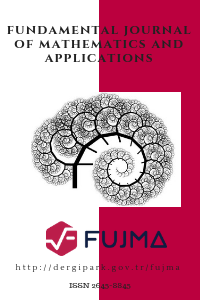Unrestricted Fibonacci and Lucas quaternions
Unrestricted Fibonacci and Lucas quaternions
Fibonacci quaternion, Lucas quaternion, Binet's formula Catalan's identity, Generating function,
___
- [1] A. F. Horadam, Complex Fibonacci numbers and Fibonacci quaternions, Amer. Math. Monthly, 70(2) (1963), 289–291.
- [2] M. R. Iyer, A note on Fibonacci quaternions, The Fibonacci Quart., 7(2) (1969), 225–229.
- [3] S. Halici, On Fibonacci quaternions, Adv. Appl. Clifford Algebr., 22(2) (2012), 321–327 .
- [4] M. N. S. Swamy, On generalized Fibonacci quaternions, The Fibonacci Quart., 11(5) (1973), 547–550.
- [5] C. Flaut, V. Shpakivskyi, On generalized Fibonacci quaternions and Fibonacci-Narayana quaternions, Adv. Appl. Clifford Algebr., 23(3) (2013), 673–688.
- [6] M. Akyigit, H. H. Kosal, M. Tosun, Fibonacci generalized quaternions, Adv. Appl. Clifford Algebr., 24(3) (2014), 631–641.
- [7] D. Tasci, F. Yalcin, Fibonacci-p quaternions, Adv. Appl. Clifford Algebr., 25(1) (2015), 245–254.
- [8] J. L. Ramirez, Some combinatorial properties of the k-Fibonacci and the k-Lucas quaternions, An. St. Univ. Ovidius Constanta, 23(2) (2015), 201–212.
- [9] F. Torunbalci Aydin, On the bicomplex k-Fibonacci quaternions, Commun. Adv. Math. Sci., 2(3) (2019), 227–234.
- [10] F. Torunbalci Aydin, Hyperbolic Fibonacci sequence, Univers. J. Math. Appl., 2(2) (2019), 59–64.
- [11] M. A. Gungor, A. Cihan, On dual hyperbolic numbers with generalized Fibonacci and Lucas numbers components, Fundam. J. Math. Appl., 2(2) (2019), 162–172.
- [12] T. Koshy, Fibonacci and Lucas Numbers with Applications, John Wiley and Sons, New York, 2001.
- [13] D. Zeilberger, The method of creative telescoping, J. Symbolic Comput., 11(3) (1991), 195–204.
- ISSN: 2645-8845
- Yayın Aralığı: Yılda 4 Sayı
- Başlangıç: 2018
- Yayıncı: Fuat USTA
Discrete Networked Dynamic Systems with Eigen-Spectrum Gap: Analysis and Performance
Magdisadek MAHMOUD, Bilal KARAKİ
Recurrence Relations for Knot Polynomials of Twist Knots
Kemal TAŞKÖPRÜ, Zekiye Şevval SİNAN
$\mathfrak{I}$-Limit and $\mathfrak{I}$-Cluster Points for Functions Defined on Amenable Semigroups
Uğur ULUSU, Fatih NURAY, Erdinç DÜNDAR
Unrestricted Fibonacci and Lucas quaternions
Ahmet DAŞDEMİR, Göksal BİLGİCİ
Construction of Degenerate $q$-Daehee Polynomials with Weight $\alpha $ and its Applications
